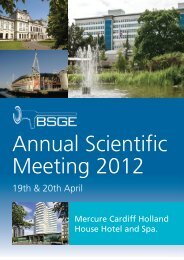Best Practice in Outpatient Hysteroscopy - British Society for ...
Best Practice in Outpatient Hysteroscopy - British Society for ...
Best Practice in Outpatient Hysteroscopy - British Society for ...
Create successful ePaper yourself
Turn your PDF publications into a flip-book with our unique Google optimized e-Paper software.
Adequate, clear and simple written patient <strong>in</strong><strong>for</strong>mation should be provided with the<br />
appo<strong>in</strong>tment letter.The <strong>in</strong><strong>for</strong>mation will vary accord<strong>in</strong>g to local circumstances and the type of<br />
service offered. Where simultaneous treatments are offered (‘see and treat’ services), it is<br />
important that this fact is reflected <strong>in</strong> the patient literature to facilitate <strong>in</strong><strong>for</strong>med choice. It is<br />
good cl<strong>in</strong>ical practice to obta<strong>in</strong> <strong>for</strong>mal consent <strong>for</strong> outpatient hysteroscopy be<strong>for</strong>e the<br />
procedure.<strong>Practice</strong> should con<strong>for</strong>m to recommendations on consent from the General Medical<br />
Council and the RCOG.The RCOG has produced ConsentAdvice No.1:Diagnostic hysteroscopy<br />
under general anaesthesia, 22 which should be used <strong>in</strong> conjunction with RCOG Cl<strong>in</strong>ical<br />
Governance Advice No. 6: Obta<strong>in</strong><strong>in</strong>g valid consent. 23 Women should be able to access advice<br />
follow<strong>in</strong>g any <strong>in</strong>tervention (e.g. a direct l<strong>in</strong>e to the cl<strong>in</strong>ic and an out-of-hours contact number).<br />
Consideration should be given to allow direct access <strong>for</strong> GPs accord<strong>in</strong>g to locally developed<br />
criteria and selected groups of women to aid streaml<strong>in</strong><strong>in</strong>g of the service.<br />
5. Analgesia<br />
5.1 Do analgesics given be<strong>for</strong>e diagnostic hysteroscopy reduce the pa<strong>in</strong> felt by women dur<strong>in</strong>g the procedure?<br />
Rout<strong>in</strong>e use of opiate analgesia be<strong>for</strong>e outpatient hysteroscopy should be avoided as<br />
it may cause adverse effects.<br />
Women without contra<strong>in</strong>dications should be advised to consider tak<strong>in</strong>g standard<br />
doses of non-steroidal anti-<strong>in</strong>flammatory agents (NSAIDs) around 1 hour be<strong>for</strong>e their<br />
scheduled outpatient hysteroscopy appo<strong>in</strong>tment with the aim of reduc<strong>in</strong>g pa<strong>in</strong> <strong>in</strong> the<br />
immediate postoperative period.<br />
A systematic review 24 identified six studies which exam<strong>in</strong>e the use of analgesics compared with controls<br />
be<strong>for</strong>e outpatient hysteroscopy. 25–30 All of these studies were randomised controlled trials.Three of the<br />
studies exam<strong>in</strong>ed the use of opiate drugs 25–27 and three exam<strong>in</strong>ed NSAIDs. 28–30<br />
Two of the opiate studies exam<strong>in</strong>ed the use of 100 mg tramadol adm<strong>in</strong>istered approximately 50<br />
m<strong>in</strong>utes be<strong>for</strong>e the outpatient hysteroscopy, one study giv<strong>in</strong>g the tramadol <strong>in</strong>tramuscularly 25<br />
and the second giv<strong>in</strong>g it as an <strong>in</strong>travenous <strong>in</strong>fusion. 26 The first study found that the women who<br />
had received tramadol had significantly less pa<strong>in</strong> at the end of the procedure than women <strong>in</strong> the<br />
<strong>in</strong>tracervical block group and the women who received no medication (P = 0.001 and P < 0.001,<br />
respectively). 25 Although this was a low-quality study, the result was supported by those from<br />
the second, high-quality study which reported significantly lower pa<strong>in</strong> scores <strong>in</strong> the tramadol<br />
group compared with placebo both dur<strong>in</strong>g (P < 0.012) and 15 m<strong>in</strong>utes after (P < 0.008) the<br />
procedure. 26 The third opiate study exam<strong>in</strong>ed the use of subl<strong>in</strong>gual buprenorph<strong>in</strong>e 0.2 mg 40<br />
m<strong>in</strong>utes be<strong>for</strong>e the procedure compared with placebo.There was no significant pa<strong>in</strong> reduction<br />
with the use of buprenorph<strong>in</strong>e overall and when stratified <strong>for</strong> menopausal status and parity. 30<br />
Two studies reported adverse effects. 26,30 The tramadol study found no significant difference<br />
between the groups <strong>in</strong> terms of <strong>in</strong>cidence of nausea, vomit<strong>in</strong>g or bradycardia. 26 Conversely, <strong>in</strong><br />
the buprenorph<strong>in</strong>e study there was a high <strong>in</strong>cidence of adverse effects (nausea, vomit<strong>in</strong>g and<br />
drows<strong>in</strong>ess) <strong>in</strong> the <strong>in</strong>tervention group (38.8%) and none <strong>in</strong> the control group. 30<br />
Three trials exam<strong>in</strong>ed the use of NSAIDs be<strong>for</strong>e outpatient hysteroscopy. 28–30 One of these<br />
studies assessed the use of 50 mg oral diclofenac 1–2 hours be<strong>for</strong>e the procedure and found that<br />
it did not significantly reduce the pa<strong>in</strong> experienced compared with placebo: mean (standard<br />
deviation) <strong>in</strong> the diclofenac group 3.0 (2.5) versus 3.0 (2.9) <strong>in</strong> the control group. 30 Vasovagal<br />
reactions were not reduced <strong>in</strong> the diclofenac group compared with the placebo group (four<br />
reactions and five reactions, respectively). The only adverse effects were <strong>in</strong> the diclofenac<br />
treatment group,but these were mild and self-limit<strong>in</strong>g (one woman reported drug rash and one<br />
compla<strong>in</strong>ed of epigastric pa<strong>in</strong>).The second NSAID study compared the use of 500 mg oral<br />
RCOG Green-top Guidel<strong>in</strong>e No. 59<br />
7 of 22<br />
Evidence<br />
level 4<br />
© Royal College of Obstetricians and Gynaecologists<br />
B<br />
B<br />
Evidence<br />
level 1–<br />
Evidence<br />
level 1–



